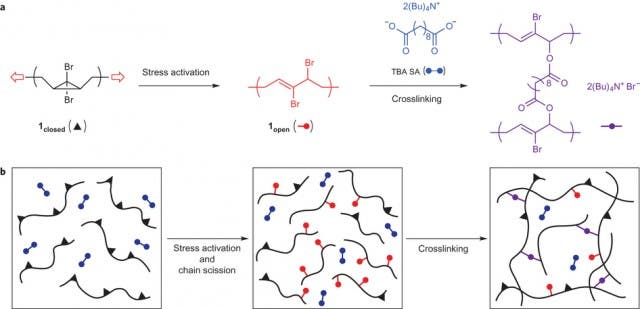Say hello to drop-proof smartphones and whole new generation of plastic products that will be far more durable and strong than their present counterparts. Scientists at Duke University recently unveiled their most recent, stunning work: a new type of polymer that seems to contradict common knowledge and re-arranges its chemical structure each time its under stress, say a mechanical shock. The test of time is in the plastic’s favor as every time the material suffers a mechanical deformation, it becomes stronger.
Plastics are the most widely used class of materials, and there’s no secret why: they’re durable, light, easy to manufacture and they last a long time (they’re lengthy half-life is also an environmental hazard, however) . Their hardness comes in various degrees, however, but what’s certain is that most of us have come to know that plastics aren’t the strongest materials. Bashed house appliances and just about any dropped plastic-based item serve as testament to this claim.
The Duke-made plastic is different. Like most plastics, the polymer is mostly made of carbon. The key difference is that these carbon atoms are arranged in a series of triangles extending down in long chains with two bromine atoms at one point. It’s this unique structure that allows the novel plastic to exhibit its unique, counter-intuitive properties.
When the plastic is tugged or comes under shock, the polymer chains tear on one side, as opposed to typical plastic polymers who do not experience the same uniform deformation leading to structural failure (breaks, cracks). The shearing force breaks the triangle into a longer chain, which also frees up bonding sites at the bromine locations for a second molecule to come in. That second molecule is a carboxylate that cross-links multiple chains and increases the material’s strength at the site of damage. This happens every time the material comes under deformation.
The material was put to the test on a larger scale after the polymer was introduced into an extruder, which forced the plastic into a mold. Before being placed intro the extruder the material was pliable, but after being molded its hardness increased significantly to the point it become very stiff. Microscopic analysis subsequently showed an increased in hardness 200-fold after the extrusion process.
It’s unclear when the polymer might be introduced in commercial applications, still the prospects are amazing.
Findings appeared in Nature. [via ExtremeTech]



